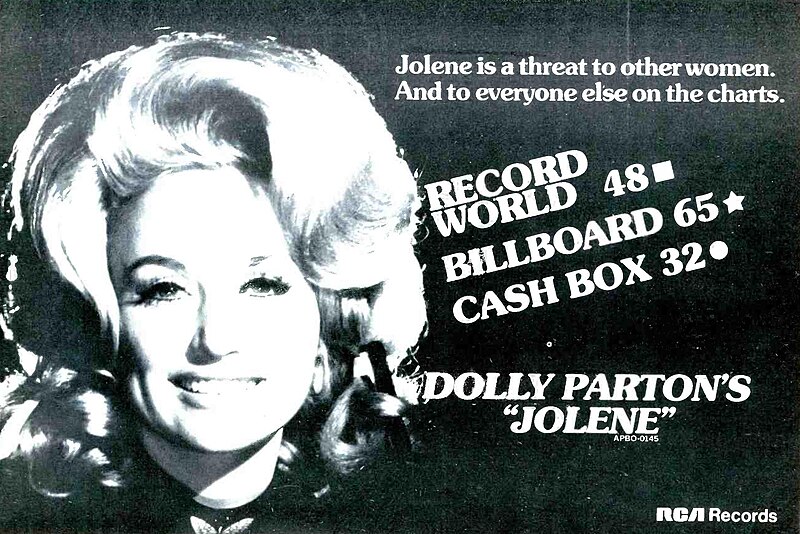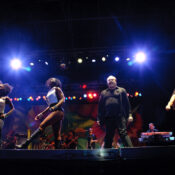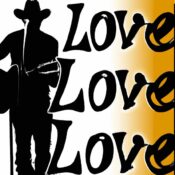It’s a new year! Let’s take a look back five decades, this time at ten big musical moments from 1974 that would shape the future.
February 4: Dolly Parton Drops Jolene
Dolly debuts “Jolene” (Uploaded to YouTube by Dolly Parton)
While Dolly Parton released the iconic single “Jolene” in late 1973, the album that shares the song’s name followed in 1974. On its own, it would be an incredibly important document of Dolly highlights. However, the album also contains “I Will Always Love You.” It’s hard to estimate which is more mind-boggling: the fact that both songs are just as popular today or the fact that Parton wrote both songs within days of each other, possibly on the same day. Both were Country #1s for the singer. “I Will Always Love You” also has the distinction of being a #1 song in three consecutive decades: 1974 (Country), 1982 (Country; a Parton re-recording for the Best Little Whorehouse in Texas soundtrack), and 1993 (Pop; Whitney Houston’s cover from The Bodyguard). The album cemented Parton as a creative and commercial force whose influence would only grow from then on.
February 18: Kiss Releases Kiss
Kiss playing “Deuce” in 1975 (Uploaded to YouTube by The Midnight Special)
One of the biggest bands on the planet, Kiss formed in early 1973 and had their familiar make-up in place by March. They were already hard at work on the road when their self-titled debut hit stores. Though it took four years to achieve gold status on the back of the huge success of 1975’s KISS ALIVE! Concert album, the record contains several of the band’s live staples, like “Strutter,” “Deuce,” and “Cold Gin.” At various points, both Gene Simmons and Ace Frehley have cited Kiss as their favorite of the band’s output.
March 30: The Ramones Play Their First Gig
The Ramones at CBGB in 1977 (Uploaded to YouTube by RamoniaCretin)
When The Ramones played CBGB for the first time in August of 1974, it launched them on the trajectory that would lead them into the Rock and Roll Hall of Fame. But the punk trailblazers’ first actual gig occurred at Performance Studios in New York that March. With the band members adopting Ramone as pseudonymous last names, their matching leather jackets, and their insanely fast tempo, the band was already different. By the end of the year, they had played 74 sets at CBGB (at about 17 minutes apiece), paving the way to be signed to Sire Records in 1975.
April 6: California Jams
The California Jam was the last of the big wave of musical festivals that began in the 1960s. It was also a record-breaker. The one-day event in Ontario, California featured (at the time) the loudest amplification system ever, the largest number of paid attendees (250,000), and highest box office gross. The show was co-headlined by Emerson, Lake & Palmer and Deep Purple, with downbill acts that included Eagles, Earth Wind & Fire, and Black Sabbath. Some FM radio stations carried a simulcast of the show, and co-sponsor ABC Television would air a few performances as segments of the In Concert series.
April 6: ABBA Wins Eurovision
ABBA at Eurovision (Uploaded to YouTube by mozpiano2)
After some previous disappointing swings at trying to represent Sweden in the Eurovision song contest, ABBA took something new to Melodifestivalen 1974, the Swedish preliminary event for Eurovision selection. They submitted their glam rock-inspired tune that compares a broken love affair to a famous battle: “Waterloo.” At the time, a number of Eurovision entrants were somewhat folky (even hokey), but ABBA leaned into a pop-rock direction and made the fairly bold decision (for the time) to sing in English. The insanely catchy tune carried them to Eurovision victory on April 6, 1974. Now instantly recognizable in Europe and with a batch of fresh material, they had a significant opportunity to make a real dent in the elusive U.S. market. “Waterloo” went #6 in the States, followed by the #27 “Honey Honey.” Napoleon may have failed at Waterloo, but for ABBA, it was the successful start of their own Swedish invasion.
May 24: Bad Company Debuts
After Led Zeppelin formed their Swan Song record label, their first release in the U.S. wasn’t one of their own albums, but the debut of Bad Company. The English supergroup consisted of bassist Boz Burrell (King Crimson), guitarist Mick Ralphs (Mott the Hoople), drummer Simon Kirke and vocalist Paul Rodgers (both from Free). The new band scored hits right out of the gate, as their self-titled release included the #5 “Can’t Get Enough” and the #19 “Movin’ On.” Several other songs from the record, like “Bad Company,” would become permanent fixtures on classic rock radio. Paul Rodgers has widely been considered one of the greatest of all rock vocalists. Though the group went through a cycle of break-ups and reunions, Kirke and Rodgers were still playing together through 2019. In November of 2023, Kirke acknowledged that the band was essentially defunct on the back of Rodgers’s health problems (which had included two strokes), but the music, from the debut on, will endure.
June 5: Patti Smith Records “Hey Joe”
There’s a never-ending debate about what the first rock and roll song is (it’s “Rocket 88”), and you’re going to get the same kind of debate about the identity of the first punk rock record. But a lot of critical consensus puts that title on the “Hey Joe/Piss Factory” single by Patti Smith. Smith was already a poet and performer, and she founded her own label, Mer Records, to release her single. She recruited Tom Verlaine, guitarist of Television, one of the first punk bands to play CBGB, to play on the record. “Hey Joe” was the latest cover of a long-running American song, but Smith also included a monologue about Patty Hearst on the track. “Piss Factory” recounted Smith’s experience with baby buggy factory work.
July 22: Commodores Debut with Machine Gun
“Machine Gun” by Commodores (Uploaded to YouTube by The Commodores)
One of the most important funk and soul groups in American history, Commodores came together when members of two groups at Tuskegee University in Alabama merged into one outfit. They won the school’s freshman talent show and signed with Motown Records after opening for The Jackson 5. The title track to their 1974 debut, Machine Gun, was their first single. The instrumental hit #22 on the pop charts, paving the way for a parade of hits that ran from ballads (“Three Times a Lady”) to funky smashes (“Brick House”). In 1982, co-lead singer and saxophonist Lionel Richie split for massive solo success while Commodores never stopped filling dance floors.
July 28: Neil Peart Joins Rush
Canadian power-trio Rush released their self-titled debut album in 1974, but the group really got going when vocalist/bassist/keyboardist Geddy Lee and guitarist Alex Lifeson were joined by drummer Neil Peart. A powerhouse of a drummer who worked his massive kit with unmatched technical precision and the panache of a showman, Peart quickly came to be regarded as one of the greatest drummers in rock. In addition to his skill in the seat, Peart also took over as the band’s primary lyricist, injecting the themes of philosophy and science fiction that set the group apart from their contemporaries.
December 31: Lindsey and Stevie Join Fleetwood Mac
“Rhiannon” by Fleetwood Mac (Uploaded to YouTube by Fleetwood Mac)
Rock and roll is rife with stories of a new member injecting new life into a band. Neil Peart (above) is a great example. But much rarer is the duo that joins a band and makes it into one of the most successful acts of all time. That’s what happened when Lindsey Buckingham and Stevie Nicks combined with remaining Fleetwood Mac members Mick Fleetwood, John McVie, and Christine McVie. The original Mac had been more deeply rooted in the blues. While searching for a new guitar player, Fleetwood liked what he heard on the duo’s Buckingham Nicks record; he invited Buckingham to join. The guitarist agreed on the condition that his singer-songwriter girlfriend could join as well. The group’s first outing, 1975’s Fleetwood Mac, yielded three hit songs (including “Rhiannon”), and the follow-up, Rumours, became one of the ten best-selling albums in the history of music.
Become a Saturday Evening Post member and enjoy unlimited access. Subscribe now




Comments
Lots of good music; singers and groups that would dominate the mid-late ’70s and beyond were definitely propelled in ’74. Magical, wonderful Dolly had been singing from a very young age, but ‘Jolene’ was really the beginning of her becoming the superstar we know and love to this day, and well into the future I believe also. Appreciate all the uploads, Troy.
What else is there to say about KISS? They were/are an amazing band that really knew early on how to put on great stage shows, but were also excellent musicians to back up the glitter, glitz and those platform shoes that definitely helped make them larger than life. ‘Midnight Special’ was such a great showcase for the heyday of some of the best music ever, during its 8 year run.
Then The Ramones; loved them too, still do. I’m sorry now about not getting to go to Cal Jam in April ’74. Great lineup, but the stars didn’t align to for my friends and I. There were parental conflicts (they were right); but it was still a bummer. Bad Company was great; still listen to them. ABBA of course (except ‘Dancing Queen’). Rush too, of course.
New additions and/or replacements are often for the better. The Doobie Brothers though, a favorite up to mid-decade, went in a completely different direction with Michael McDonald I never liked, and really still don’t care for to this day.
Fleetwood Mac was definitely taken to new heights with the additions of Linsey and Stevie. I really loved 1975’s ‘Fleetwood Mac’ album, but then skips ahead to 1979’s ‘Tusk’. ‘Rumours’ selections were way overplayed at the time, and the album frankly was a lot more average than it was cracked up to be.